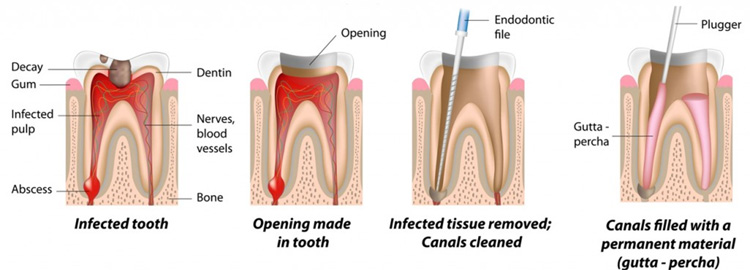ROOT CANAL TREATMENT
What is a root canal?
Patients typically need a root canal when there is inflammation or infection in the roots of a tooth. During root canal treatment, an endodontist who specializes in such treatment carefully removes the pulp inside the tooth, cleans, disinfects and shapes the root canals, and places a filling to seal the space.
When is a root canal needed?
Root canal therapy is necessary when oral
bacteria invade the pulp inside of your
tooth. This usually happens when a cavity is left untreated for a long time. It can also
occur if your tooth becomes cracked or damaged
due to trauma.
What are some symptoms
that indicate you may need root canal treatment?
· Tooth pain that doesn’t go away.
· Sensitivity to heat
and cold.
· Swollen gums.
· Pimple on the gums.
· Swollen jaw.
· Tooth discoloration.
· Pain when pressure is applied.
· A chipped or cracked tooth.
· Loose tooth.
How
common is root canal therapy?
According to the American Association of Endodontists, over
41,000 root canals are
performed in the United States every day.
That means that more than 15 million root
canals are completed each year.
What happens during
the root canal process?
Before
beginning your root canal, your healthcare provider will take dental
X-rays of the affected tooth. This helps
determine the extent of damage and ensures that root canal therapy is the
appropriate treatment option. Here are the steps that will be completed during
your root canal procedure:
1.
Anesthesia.
First,
local anesthesia is given to numb the infected tooth and the surrounding gums.
There are also medications used in dentistry to help you relax, such
as nitrous oxide, oral sedatives or intravenous (IV) sedation. Your healthcare
provider may recommend sedation if you struggle with dental anxiety.
2.
Dental
dam placement.
Before
beginning root canal treatment, a small rubber dam is placed over the area.
This isolates the tooth and keeps it dry during the procedure.
3. Access hole.
Next, a
small opening is made in the crown of the tooth to access the pulp.
4.
Pulp
removal.
Tiny dental instruments
are used to remove the nerves, blood vessels and tissues inside the tooth.
5.
Shaping
the canals.
Once the pulp is
removed, the pulp chamber and root canals are cleaned, disinfected and shaped.
6.
Filling
the canals.
The empty canals are
then filled with a flexible, rubbery dental material called gutta-percha.
7.
Sealing
the tooth.
Next, a temporary dental
filling is placed to seal the tooth and prevent bacteria from re-entering.
8.
Placing
the final restoration.
In most cases, you’ll
need a dental crown to protect the treated tooth and restore your
bite. Crowns are custom-made, and fabrication usually takes two to three weeks.
When your crown is ready, the temporary filling is removed and the permanent
crown is placed. In some instances, you may be able to receive a crown during
the same appointment.
· Are root canals safe?
Root canals are considered safe and
effective. This procedure boasts impressive
Success rates of up to 98%.

